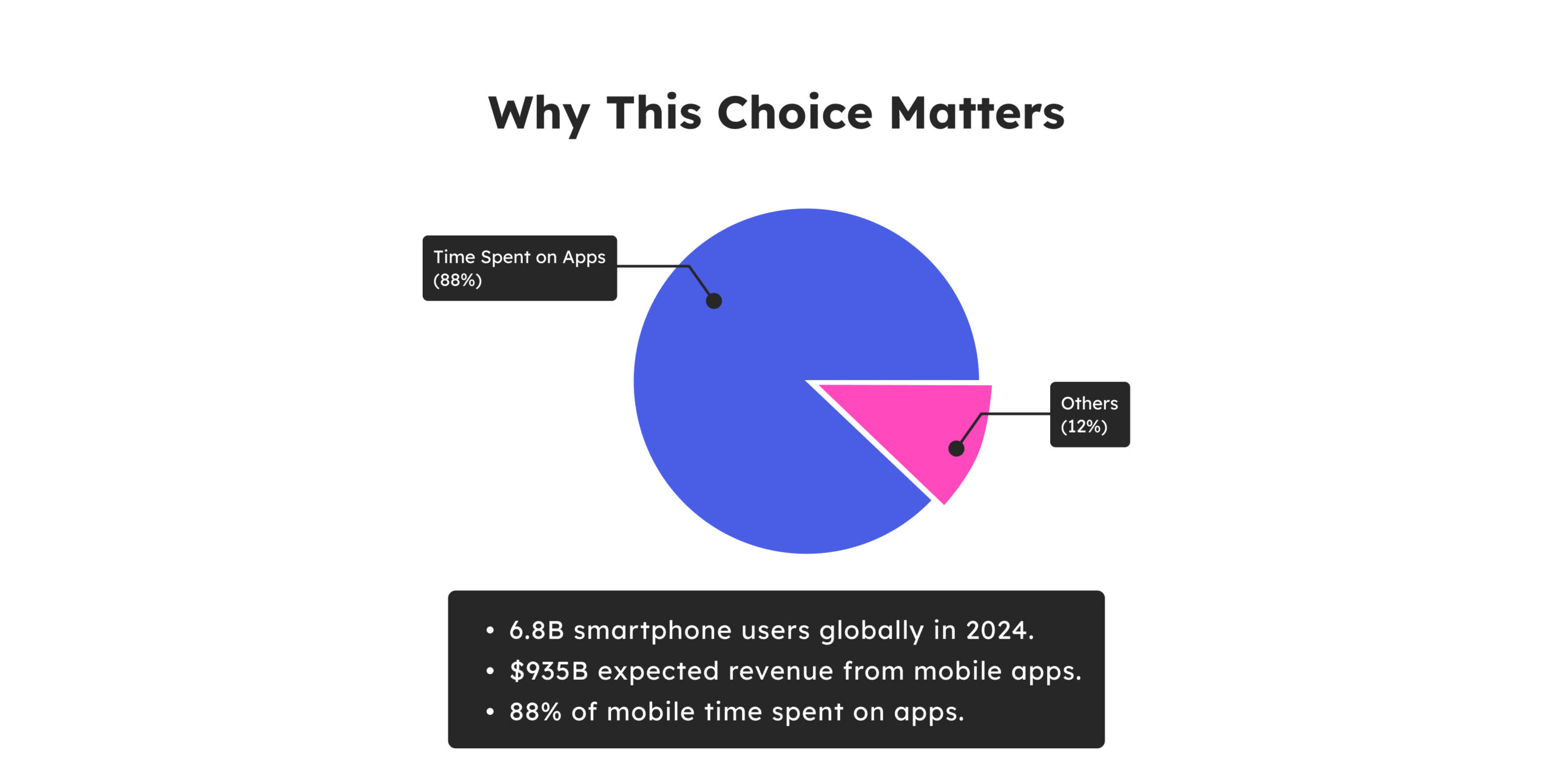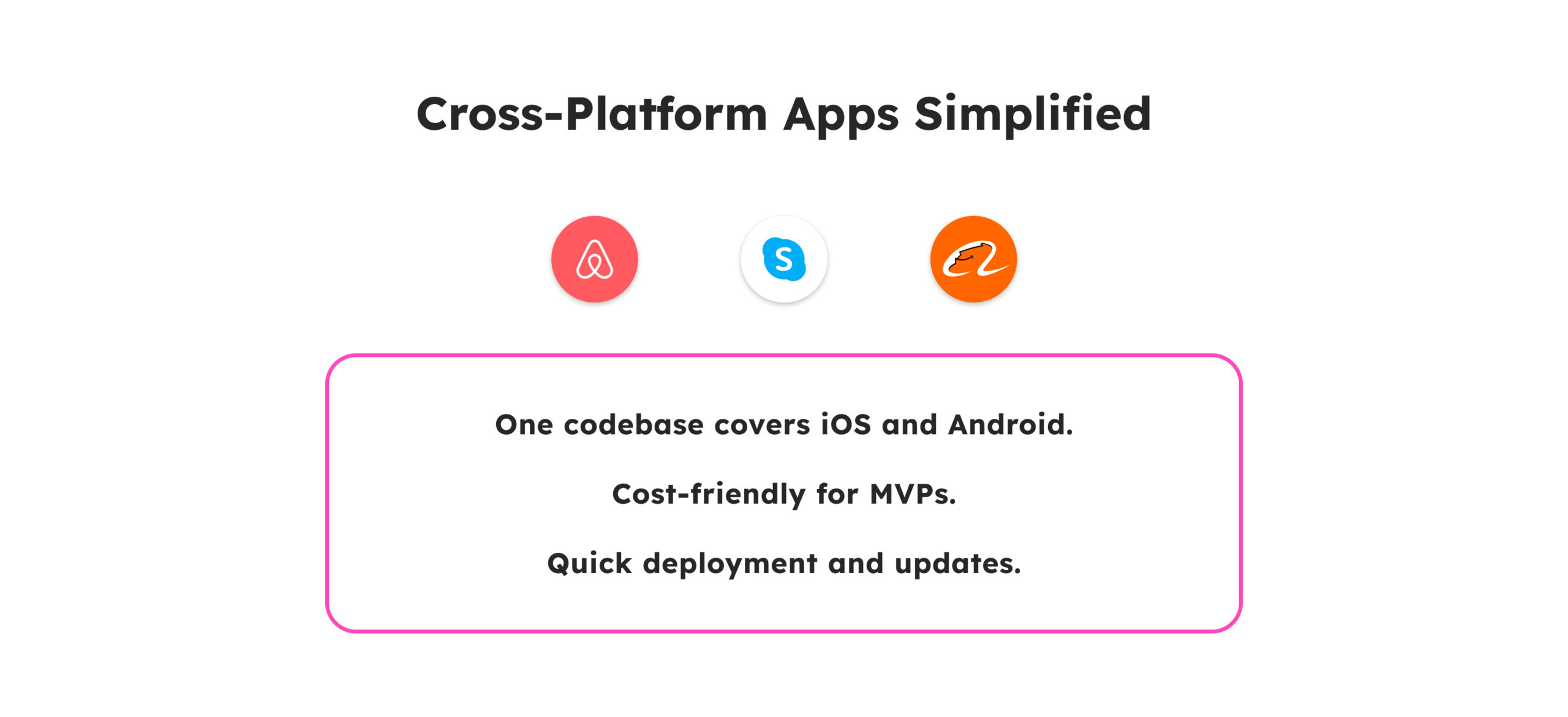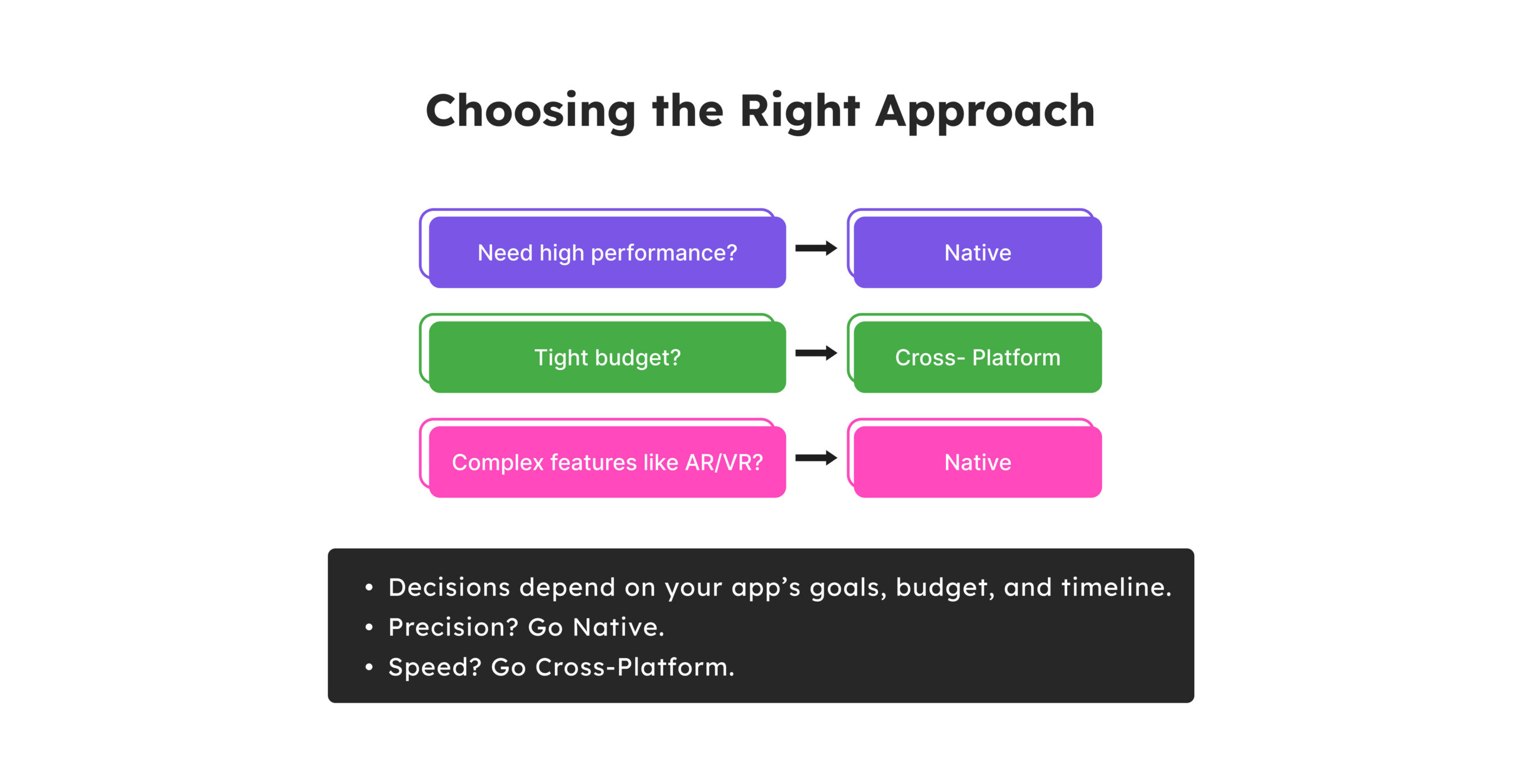“Building an app? Choose wisely—because the platform war is real, and your business is on the frontline.”
Introduction: Cracking the Code of App Development
Alright, let’s talk apps. You’ve got this brilliant idea, maybe even a roadmap, and now you’re standing at the crossroads of app development, faced with the burning question: native or cross-platform? Sounds straightforward, right? Spoiler alert—it’s not. This isn’t just about picking a tech stack; it’s about deciding the very DNA of your app. The user experience, the speed-to-market, your budget, and future scalability all hinge on this choice. No pressure or anything.
Think of it as the ultimate app development showdown. On one side, we have Native Apps, the purists of the app world, offering tailor-made experiences but demanding a bit of extra cash and coding love. On the other, there are Cross-Platform Apps, the scrappy, cost-effective multitaskers that promise you a broader reach without doubling your dev work.
And let’s be real—make the wrong choice, and your app could vanish into the app store’s graveyard faster than a buggy update. That’s not where you want to be, right?
But hey, don’t stress. We’re here to cut through the tech jargon, stack the pros and cons, and serve up real-world examples that’ll help you make an informed, killer decision. So buckle up! Whether you’re here to build the next big thing or just figuring out what’s best for your business, this blog’s your ultimate cheat code to cracking the app conundrum. Let’s get started!
Why This Matters: Getting It Right Is Non-Negotiable

Alright, let’s get serious for a second—this isn’t just another tech decision. Choosing between native and cross-platform development is like picking the foundation for a skyscraper. Get it right, and you’re reaching for the stars. Get it wrong, and you’re looking at cracks, collapses, and a whole lot of regret. Still think it’s not a big deal? Let me break it down for you.
1. Market Share Isn’t Just a Stat—It’s Survival
Picture this: 6.8 billion smartphone users globally in 2024. Let that sink in. And here’s the kicker—mobile apps are raking in a jaw-dropping $935 billion in revenue. That’s the kind of money that turns startups into unicorns. But here’s the catch: picking the wrong development approach could leave you stranded, waving goodbye as competitors claim your piece of this booming market.
2. Users Demand Perfection (No Pressure)
Here’s the brutal truth—users don’t just want great apps; they expect them. A mind-blowing 88% of mobile time is spent on apps. But if your app stutters, crashes, or looks like a throwback to 2005? Kiss those users (and their wallets) goodbye. People don’t stick around for second chances; they uninstall, rant in reviews, and move on. Your development choice plays a massive role in whether your app delivers buttery-smooth performance or becomes the next meme-worthy disaster.
3. ROI Is King—Don’t Blow Your Budget
Money doesn’t grow on trees, especially when it comes to app development. Go too fancy with a native without planning your budget, and you could blow through your funds faster than a startup’s launch party. Go too cheap with cross-platform, and you might end up paying double in patches and updates when things go sideways. This decision isn’t just about now—it’s about setting up your app for long-term ROI and scalability.
4. Tech Trends Are the Game-Changers
The future is here, and it’s wearing augmented reality glasses and running on AI algorithms. These technologies are driving app trends, reshaping how we interact with mobile platforms. But here’s the rub—your development choice could be the difference between riding the AR/AI wave or getting wiped out by it. Native apps might give you the edge in harnessing cutting-edge tech, while cross-platform could offer versatility but with limitations.
What Is a Native App?

Let’s cut to the chase: native apps are like the VIPs of the app world. They don’t play by the “one-size-fits-all” rule—they’re tailored, polished, and built to shine on a specific platform, whether it’s iOS or Android. Think of them as the luxury sports cars of app development: sleek, powerful, and optimized for the road (or platform) they’re built for.
1. Built Specifically for One Platform
Native apps don’t do shortcuts. They’re crafted using platform-specific languages—Swift/Objective-C for iOS and Kotlin/Java for Android. What does that mean for you? These apps are designed to work seamlessly with their respective operating systems, with no compromises. It’s like having a custom-made suit versus an off-the-rack one—it just fits better.
2. Leverages Platform-Specific APIs for Next-Level Performance
Here’s where native apps flex their muscles: they tap directly into the platform’s APIs, meaning they’re perfectly synced with the OS. The result? Lightning-fast performance, smoother animations, and seamless integrations. It’s the difference between a Ferrari hugging every curve of the road and a budget car chugging along. Native apps are the ones your users will rave about because they just work.
3. Best For High-Performance, AR/VR, and Killer UX
If you’re dreaming big—think augmented reality, virtual reality, or apps with intricate designs and complex functionalities—native is your go-to. Why? Because native apps aren’t just fast; they’re buttery-smooth, hyper-responsive, and drop-dead gorgeous. They give you the edge when user experience can make or break your app’s success.
4. Real-World Rockstars: WhatsApp, Spotify, and Pokémon Go
Need proof? Take a look at WhatsApp—known for its blazing speed and reliability, or Spotify, which handles millions of songs and playlists without breaking a sweat. And then there’s Pokémon Go, the AR legend that took the world by storm. These apps are proof that when you go native, you go big.
Why Go Native?
Because your users deserve an app that feels like magic—not one that frustrates them into uninstalling, native apps deliver the speed, finesse, and reliability your app needs to win hearts and top the charts. Sure, they might be pricier to develop upfront, but if you’re serious about making waves (and profits), they’re worth every penny.
So, are you ready to go native and join the big leagues? Or are you still thinking about playing it safe? Let’s move on and weigh your options.
What Is a Cross-Platform App?

Let’s talk about the jack-of-all-trades in the app development world: cross-platform apps. These apps are the multitaskers, the Swiss Army knives of the app ecosystem, built to work on multiple platforms with a single codebase. If native apps are the bespoke suits, cross-platform apps are the budget-friendly yet stylish outfit you can rock anywhere. They’re not about perfection—they’re about practicality. And sometimes, that’s exactly what you need.
1. One Codebase, Two Platforms—It’s Efficiency at Its Best
Here’s the deal: cross-platform apps are developed using frameworks like Flutter, React Native, or Xamarin. The magic? You write one codebase and deploy it across both iOS and Android. Think of it as cooking one big batch of soup and serving it to two different tables—the same effort, double the reach. For businesses trying to maximize their impact without doubling their dev costs, this is a no-brainer.
2. Faster Deployment, Smoother Updates
Do you have a deadline breathing down your neck? Cross-platform development has your back. With a shared codebase, you’re cutting development time significantly, which means your app hits the market faster. Need to fix a bug or roll out an update? Do it once, and it’s live everywhere. It’s the ultimate time and money saver, especially when you’re testing ideas or operating on a tight budget.
3. Best For Budget-Savvy Businesses and Simple-to-Mid-Level Apps
Cross-platform apps thrive when the stakes aren’t sky-high. They’re perfect for startups, MVPs (Minimum Viable Products), or apps that don’t need heavy-duty features or complex functionalities. If your app doesn’t require AR, VR, or the kind of performance that could rival a gaming console, cross-platform gets the job done—efficiently and affordably.
4. Real-World Success Stories: Airbnb, Skype, and Alibaba
Don’t underestimate cross-platform’s potential—it’s got some big names on its roster. Airbnb uses it to ensure a consistent user experience across platforms, Skype taps into it for its global communications platform, and Alibaba relies on it to handle millions of transactions daily. These companies prove that with the right approach, cross-platform can be a powerhouse.
Why Choose Cross-Platform?
Because sometimes, being practical is the smartest move you can make. Lower costs, faster time-to-market, and the ability to test waters across multiple platforms make cross-platform a go-to choice for businesses that want to stay lean without sacrificing quality.
But don’t get too comfortable—cross-platform apps aren’t invincible. They might stumble when it comes to ultra-high performance or accessing the latest platform-specific features. Still, if you’re focused on getting your app out there quickly and cost-effectively, cross-platform could be your golden ticket.
So, is this the shortcut your business needs? Or are you aiming for perfection with natives? Let’s keep exploring.
Native vs. Cross-Platform

| Feature | Native Apps | Cross-Platform Apps |
| Performance | They are blazing Fast! These are the Olympic sprinters of apps—built to dominate their platform. | Pretty Good. They’re like reliable all-rounders but might huff and puff with heavy-duty features. |
| Development Time | Patience, Grasshopper. Two platforms = two codebases = more time. | Speedy Gonzales! One codebase means you’re racing to launch in record time. |
| Cost | Bring Your Wallet. Native apps are the luxury cars of development—worth it, but pricey. | Budget-Friendly. Think carpooling instead of splurging on two separate rides. |
| User Experience (UX) | Top-Notch. Designed to feel like home for iOS and Android users. Think: silky smooth. | Decent. It’ll work just fine but might miss that “wow” factor hardcore users expect. |
| AR/VR Suitability | Next-Level. If you’re diving into AR/VR, native is like a VIP pass to a performance. | Hit or Miss. It’ll manage the basics but don’t expect jaw-dropping experiences. |
How to Decide: The Battle Plan for Your Business
Choosing between native and cross-platform isn’t just a tech decision—it’s a business-defining move. Let’s map it out so you can make the call without losing sleep. Here’s where each option shines, depending on your app’s mission.

When to Go Native: All-In for Performance and Precision
-
High Performance is Non-Negotiable:
If your app needs to handle lightning-fast gameplay, immersive AR, or crystal-clear live streaming, native is the boss. Think of it this way—would you race a Formula 1 car on a go-kart track? Nope. Gaming apps, AR experiences, and live-streaming platforms demand precision and power, which native apps deliver like a pro.
-
Audience-Specific Features:
Are your users glued to iPhones, or are they die-hard Android fans? Native development speaks their language, literally. You can craft platform-perfect designs and leverage those exclusive features—like Face ID for iOS or custom widgets for Android—that users love. When your audience deserves tailored greatness, native wins.
-
Security-Focused Apps:
If you’re dealing with money, data, or sensitive transactions (hello, banking apps!), you can’t mess around. Native apps let you integrate secure features directly with the platform, ensuring your users’ trust and your reputation remain bulletproof.
When to Go Cross-Platform: Smart, Fast, and Budget-Friendly
-
Speed to Market:
You’ve got a killer idea, and you need it live yesterday. Cross-platform frameworks like Flutter and React Native get you there. Launch on iOS and Android simultaneously, grab user feedback, and iterate. It’s like hitting “fast-forward” on your startup journey.
-
Budget Constraints:
Let’s face it: not every app starts with Silicon Valley-level funding. If your wallet’s feeling light, cross-platform development helps you stretch those dollars. You’ll save on development costs without sacrificing a solid user experience—win-win, right?
-
Feature Uniformity:
If your app doesn’t need flashy, platform-specific features and just needs to work well across devices (think e-commerce, productivity tools, or social apps), cross-platform is your BFF. It keeps things consistent, simple, and effective—no extra bells and whistles required.
Real-World Examples: When Big Brands Picked Their Side
Let’s talk about the heavyweights of the app world—those who’ve already walked the native vs. cross-platform tightrope and come out swinging. Here’s how they played their cards, why they made their choices, and what you can learn from their success stories.
From India: Apps That Dominate the Subcontinent
- Zomato (Native): Because Speed and Precision Feed the Hunger
When it comes to food delivery, milliseconds matter. Zomato, India’s culinary lifeline, chose native app development to ensure high performance, real-time updates, and silky-smooth UX. From tracking your butter chicken in real time to personalized restaurant suggestions, Zomato uses native development to keep the experience snappy and ultra-reliable. In the high-stakes world of food delivery, every tap counts—and native made it happen.
- Ola (Cross-Platform): Moving Fast, Literally and Figuratively
India’s ride-hailing giant Ola initially went cross-platform to speed up deployment and maintain consistency across the vast and diverse Indian market. When you’re connecting millions of users across hundreds of cities, you need to roll out updates fast. With cross-platform frameworks, Ola could focus on scaling and simplifying user experiences without doubling their development effort. It was the perfect launch strategy for a fast-moving business.
From Across the Globe: Global Giants Who Chose Their Path
- Instagram (Native): For That Picture-Perfect Experience
Instagram didn’t just want to create another social app; it wanted to revolutionize how people connect visually. To deliver seamless UX, blazing speed, and flawless camera integration, Instagram went native. The result? A scrolling experience so smooth it’s practically hypnotic. With features like Stories and Reels relying heavily on platform-specific optimizations, native was a no-brainer for this photo-sharing powerhouse.
- Uber (Cross-Platform): Speed to Market for a Global Takeover
When Uber was still a scrappy startup aiming to conquer the world, it embraced cross-platform for its early development. Why? Faster deployment and consistency. With users and drivers scattered across continents, cross-platform allowed Uber to scale quickly while ironing out region-specific nuances. The strategy? Take over markets first, optimize later—and it worked like a charm.
What Can You Learn from These Titans?
- For High Stakes and High Performance: If your app demands top-tier UX and performance (like Instagram or Zomato), go native. It’s the Ferrari of app development—expensive but unbeatable on the track.
- For Speed and Scalability: If you’re breaking into a competitive market or need to launch yesterday (like Ola or Uber), cross-platform gets the job done without breaking the bank.
Statistics That Seal the Deal
- 75% of mobile users abandon apps with poor performance, emphasizing the need for native apps in critical use cases. (source)
- Flutter grew by 37% in 2023, showcasing the rising appeal of cross-platform frameworks. (source)
- AR apps will hit n in revenue by 2025, with 80% favoring native platforms due to superior integration (source)
Wrapping it Up: The Big Picture
In a world that’s constantly racing towards innovation, it’s easy to get overwhelmed by trends, strategies, and the “next big thing.” But here’s the deal: what separates the leaders from the laggards is action—real, tangible, game-changing action. Whether you’re an entrepreneur, educator, or someone simply passionate about revolutionizing learning experiences, your move today could shape the future of education tomorrow.
The power of collaboration and cutting-edge technology is undeniable. This is where Colladome steps in—a platform designed to bring together visionaries and innovators to build impactful partnerships. Whether you’re looking to network, scale, or learn from the best, Colladome’s ecosystem can be your ultimate launchpad. Check it out here and see how you can accelerate your growth journey.
Call to action
So, what’s stopping you? Dive into these insights, pick a strategy, and implement it with laser focus. Oh, and don’t just sit on the sidelines—leave a comment, share this blog, and tell us what resonated most. Together, we can create ripples in the EdTech ecosystem that will be felt for generations.
Ready to make waves? Start by exploring Colladome to connect with other changemakers. Whether you’re scaling your startup, looking for strategic partnerships, or aiming to expand your network, Colladome is the place to be for trailblazers like you.
Let’s not just talk about innovation—let’s live it. The future is waiting, and it’s yours to shape. Don’t wait. Click, connect, and create with Colladome today.






